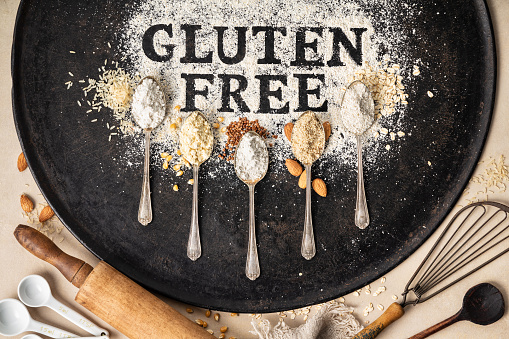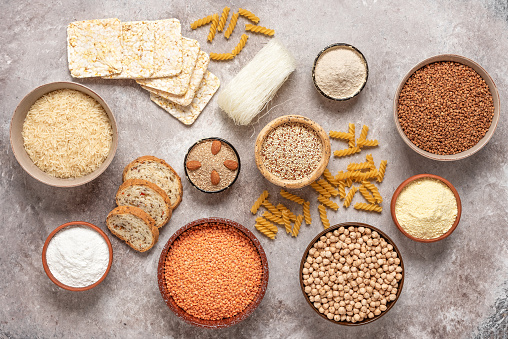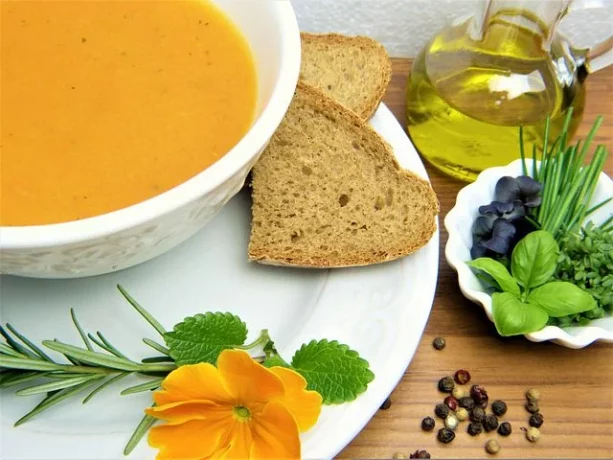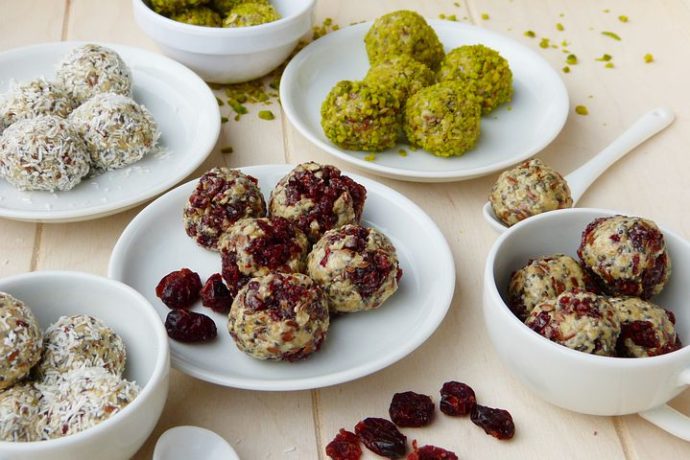With the increasing awareness about gluten-related health issues, gluten-free foods have become increasingly popular. But, many people get confused when buying gluten-free foods. And some foods claim to be gluten-free but are not. However, there are still many natural and cost-effective gluten-free sources available. If you’re wondering how to get your hands on gluten-free food, then keep reading this article.
Begin with vegetables, and add healthy fats like fruit and eggs before selecting a few hygienic meat proteins or plant-based protein options. This article will detail the best gluten-free meals for your diet.
What Is Gluten?
Gluten is a structural protein in cereal grains, including wheat, rye, and barley. In medical terms, gluten refers to two proteins, glutelin, and prolamin. Gluten naturally has adhesive and elastic properties.
The presence of gluten gives elasticity and softness to the dough and a firm shape and chewy texture to the baked product.People who are gluten-intolerant such as those with conditions like celiac disease need gluten-free foods.
Gluten-Free Foods
All fresh and unprocessed foods are often gluten-free. But, with the inclusion of certain additives, these foods can often become harmful for people sensitive to gluten. You can also try the best gluten free meals that you can prepare at home. Here, we have discussed different food categories and how you can ensure a gluten-free diet. We have covered the following types of foods in detail;
- Grains and Starches
- Fruits and Vegetables
- Dairy Products
- Fats and Oils
- Meat and Poultry
- Spices, Marinades, and Sauces
- Drinks and Beverages
Gluten-Free Grains And Starches
Whole grains are an important part of a healthy diet. These grains are a great source of carbohydrates which are excellent for gaining energy. Therefore, it is essential to include whole grains in your daily diet.
A wide selection of whole grains is naturally gluten-free, but some grains may contain gluten. Thus, checking for the certified “gluten-free” label is vital before buying whole grains.
Plus, the processing and packaging facilities must follow premium quality standards. The caution is because gluten-free grains may get contaminated with gluten-containing grains. This is especially probable if both types are processed within the same facility. Nonetheless, certified manufacturers follow high-quality protocols and ensure premium processing and packaging standards.
Natural Gluten-Free Grains And Starches
There is a long list of natural, gluten-free foods. Gluten-free starches and whole grains include quinoa, white rice, brown rice, tapioca, millet, oats, corn, teff, sorghum, buckwheat, cassava/yuca, amaranth, and potato and potato flour.
Although all these natural foods are gluten-free, checking for the “gluten-free” label on the packaging is vital. Double-checking the ingredients is essential because some grains, such as oats, are often cross-contaminated with gluten-containing grains, wheat, and barley.
Gluten-Free Cereal And Pasta
You can find an extensive range of gluten-free cereal on the market. Most brands have started producing a variety of top favorite flavors in the gluten-free range. However, not all cereals are gluten-free, so checking the ingredients list is essential. If you have gluten tolerence issues you can also try plant based diet that hold lentils, chickpeas, peanuts, quinoa and tofu.
Similarly, a broad range of pasta is available in the gluten-free category. No matter which pasta shape or size is your favorite, you can find that in the gluten-free pasta range.
The best thing is that the flavor and texture of gluten-free pasta are the same as its gluten-containing counterpart. If the packaging does not mention “gluten-free, “do not buy that product.
Gluten-Free Bread And Baked Snacks
A difficult task for anyone looking for gluten-free foods is buying items containing different forms of wheat. Bread, cakes, cookies, and snacks are a few such most prominent baked items. However, with the increased awareness about gluten-related health issues, most brands have dedicated a separate section for gluten-free baked products.
Still, it is important to note that you may only find a handful of flavor options in these baked products. Gluten-free products include energy bars, pretzels, waffles, bagels, and cookies. There are several reliable brands available in the market that offer gluten-free bread. You can either buy these fresh bread or order frozen gluten-free bread online.
In the snacks section, you may find a wide range of gluten-free chips, including potato and corn chips. Moreover, many trustworthy brands offer a wide variety of gluten-free candies for health-conscious customers. But, no matter what snack, bread, or sweet you purchase, check the “gluten-free” label.
Ingredients To Avoid While Buying Gluten-Free Grains
It is crucial to check the list of ingredients before buying anything labeled gluten-free. Generally, manufacturers include gluten-containing additives in these products to maintain texture and shape.
Wheat is one of the most distinguished sources of gluten and is a widely used gluten-containing ingredient in baked items. Different wheat varieties are available naturally, all containing an ample percentage of gluten. Therefore, looking for all these wheat varieties in any food is essential to avoid gluten. It would be best to avoid whole wheat, graham, wheat berries, farina, bulgur, Kamut, durum, spelt, and bromated flour.
Other important ingredients to look out for include rye, barley, malt, and Triticale. Triticale is the product of a cross between rye and wheat. Hence, if you are looking for “gluten-free” foods, do not buy products containing any of the abovementioned ingredients.
Gluten-Free Fruits And Vegetables
Fresh fruits and vegetables are the best ingredients to include in a gluten-free diet. With a couple of exceptions, all fresh fruits and vegetables are gluten-free. Hence, you can be creative with these gluten-free natural resources. You can use them as ingredients to prepare tasty, nutritious, and fulfilling meals.
These fresh resources are an exceptional source of vitamins, antioxidants, and minerals. All these nutrients are crucial to maintaining your overall health. Thus, dive into the greens and fruits of the produce section of your grocery store without worrying about gluten intake.
Several other packaged fruits and vegetables are available in the same section. These items include canned, frozen, pre-chopped, and dried fruits and vegetables. Like all other packaged foods, it is vital to look for a “gluten-free” label on the packaging.
Canned And Frozen Frozen fruits And Vegetables
You may find sneaky gluten in the canned and frozen foods section. Mostly, manufacturers package gluten-free frozen fruits and vegetables. Still, you may find gluten-containing ingredients in these cans as a preservative. Therefore, always go through the ingredients list on these cans. If there is a long list of ingredients, there is a probability of a gluten-containing ingredient.
It is preferable to buy frozen fruits and vegetables packaged without sauces. Otherwise, if you are looking to buy canned fruits and vegetables, look for those packaged with natural juices or water. These options are better than water-containing preservatives or other additives.
Generally, single types of frozen vegetables or fruits, such as a pack of frozen peas or a pack of frozen carrots, are free from cross-contamination. You can read the label to check for the “gluten-free” mention. Plus, trustworthy companies also invite any queries regarding manufacturing and processing quality standards.
Hence, if you are unsure about the quality standards of the facilities or wish to find out about a certain ingredient in detail, then you can contact the manufacturer.
Dried Fruits And Vegetables
In general, dried and unsweetened fruits and vegetables are gluten-free. Still, you can expect some exceptions. So, it is wise to check the content list on the packaging to ensure the product is gluten-free.
Pre-Chopped Fruits And Vegetables
Pre-chopped fruits and vegetables may include gluten-containing ingredients to increase the contents’ shelf-life. It is possible that the cutting boards during the chopping and cutting process cause cross-contamination with the gluten-containing ingredients within the facility. Therefore, buying pre-chopped products from certified and reliable companies is crucial.
Hidden Ingredients Representing Gluten In Fruits And Vegetables
If you find hydrolyzed wheat protein in the ingredients section, then the product contains gluten. Also, look for modified food starch. The presence of starch indicates that the product may contain wheat. You can also confirm the presence of meat by contacting the manufacturer.
Next comes the gluten stabilizer. As the name indicates, a gluten stabilizer maintains the freshness and vibrancy of fruits and vegetables. Furthermore, avoid products containing any ingredient containing malt. You may find malt vinegar, syrup, or malt flavors in the canned fruits and vegetables.
All these ingredients indicate that the specific food item is not gluten-free. However, if you are unsure about other ingredients, contact the manufacturers before using the product.
Safe Ingredients Found In Packaged Fruits And Vegetables
Indeed, not all additives in packaged fruits and vegetables contain gluten. Certain ingredients are safe for a gluten-free diet. These ingredients include cornstarch, distilled vinegar, potato starch or potato starch flour, oat gum, mono- and diglycerides, malic acid, lactic acid, and citric acid.
There are various fruits and vegetable supplements in the market as well to provide the same benefits as the real ones.
Gluten-Free Dairy Products
In general, milk and dairy products are gluten. Still, it is essential to observe the ingredients to ensure that you are not taking gluten. Below, we have explained the “gluten-free” status of all commercially available milk and dairy products.
Plain Milk And Yogurt
First, there is no need to worry about consuming plain milk and plain yogurt, as these are gluten-free. Plain milk contains all sorts of milk, including whole, skimmed, semi-skimmed, or heavy cream. However, although plain yogurt is gluten-free, check the ingredients list to clarify doubts.
Flavored Milk And Yogurts
Checking the ingredients list of flavored milk and yogurts is essential as they may contain gluten. The artificial or natural colors and flavors of these flavored dairy products may have gluten.
Plus, the manufacturers also add some preservatives containing gluten to stretch the shelf life of these products. Moreover, some yogurts also contain granola or cookies. Therefore, look for the label before purchasing any yogurt.
Cheese And Processed Cheese Products
Cheese and processed cheese products may also have certain gluten-based ingredients. These gluten additives improve these products’ taste and texture and increase their shelf life.
It’s best to double-check the ingredients list before purchasing cottage cheese, ricotta cheese, string cheese, cheese sauce, powdered cheese, blue cheese, cheese spreads, queso cheese, processed American cheese, and dairy-free cheese.
Additionally, avoid using “beer-washed” or “washed-rind” cheese as it surely contains beer and thus gluten. In addition to cheese and processed cheese products, read the label on the baked cheese products and cheesecakes.
Another important thing to consider while purchasing cheese is to check its packaging procedure. Sometimes manufacturers send unpackaged products to individual grocery stores to cut them into preferred sizes and then repackage them.
There is a possibility that the staff cut the cheese on the cutting boards where they prepare sandwiches, thus changing the cheese’s content. Therefore, getting cheese that the manufacturer has directly packaged is advisable.
Malted Dairy Products
Malted dairy products such as malted shakes and smoothie diet come in gluten-containing Diet. Malt is sourced from barley which naturally contains about 5 to 8 percent gluten.
Ice Creams And Ice Cream Treats
Indeed, you may find a wholesome range of gluten-free ice creams and ice cream products in the market. Still, it is crucial to check the ingredients list. Check for the phrases or ingredients like cream, cookies, cookie dough, and chocolate chip cookies.
Ice creams containing cookies, granola, and similar ingredients are not gluten-free. The same goes for all sorts of ice cream treats, including ice cream sandwiches, frozen fruit pops, and other ice cream desserts.
Milk Substitute Products
Furthermore, it is preferable to double-check the label of milk substitute products. These substitute products are generally present in the dry goods section, not in the dairy products section. Some of these substitute products are gluten-free, whereas some are not. Two of the most common gluten-free substitute products are soy milk and almond milk.
The reason for the presence of a small percentage of gluten in these milk substitute products is that these products are processed with barley enzymes. These barley enzymes can be harmful to people avoiding gluten products.
Gluten-Free Fats And Oils
Fats and oils are naturally free from gluten. However, it’s best to look at the label of the product’s packaging. Sometimes manufacturers may add gluten to enhance the flavor and texture of the fats and oils. Thus, you should carefully check the ingredients of cooking sprays and flavored oils as they may contain certain additives with gluten.
Most commonly used fats and oils include butter and ghee, which are safe to use as gluten-free foods. Other gluten-free fats and oils include olive oil, avocado oil, and vegetable oil. You can also freely consume seed oils such as canola oil, sesame oil, and sunflower oil as gluten-free.
Gluten-Free Meat And Poultry
Most animal protein sources are naturally gluten-free. But processed meat may contain gluten-containing ingredients, including spices, flour, vinegar, and sauces. Therefore, if you wish to enjoy a healthy gluten-free diet, increase your intake of natural and unprocessed meat.
All types of red meat, including fresh pork, lamb, beef, bison, duck, and goat, are gluten-free. The same goes for poultry. Fresh chicken and turkey without any marinade sauce or preservatives are gluten-free.
Processed Gluten-Free Meats
Processed meat includes sausages, salami, hot dogs, and canned meats. There are plenty of meat-providing companies that offer premium quality gluten-free meats. However, there is always a risk attached to the presence of gluten-containing products in packaged foods.
Checking the ingredients list and proportion is particularly important when buying gluten-free sausages. Many manufacturers add breadcrumbs during the processing to maintain their shape and texture.
Furthermore, if sausages do not contain any gluten-containing ingredient, there are still high chances that they may have come in contact with gluten-containing sausages or equipment during processing. So, in addition to confirming the ingredients, check the quality standards followed by the manufacturers.
Many of these companies follow the FDA guidelines of keeping the gluten content 20 ppm or below to label their products “gluten-free.” But only a few of these companies make their products entirely gluten-free.
You can check the ingredients list and their percentages to note the amount of gluten-containing ingredients in the meat products. You may find a couple of meat brands providing gluten-free bacon and hot dogs.
Burger Patties And Other Meat Substitutes
Many brands offer burger patties, veggie burgers, and similar meat substitutes. The manufacturers may have used specific gluten-containing ingredients such as spices, fillers, or sauces while preparing these products. Thus, it is essential to check the ingredients list beforehand.
Ground Meat And Ground Turkey
Although fresh meat and poultry are naturally gluten-free, ground meat and turkey may contain gluten. Generally, the companies add gluten-containing fillers to the ground meat or turkey. So, be sure to take a look at the label.
Pre-Packaged Gluten-Free Meats
A great alternative to processed meat, or even meat in general, is buying pre-packaged gluten-free meat. Reputable companies follow premium quality control standards throughout the cutting and packaging process. These companies have separate sections for processing different types of meats, thus nullifying chances of cross-contamination.
In addition, quality control teams continually check their facilities to maintain the high-quality protocol. So, it is better to go with the pre-packaged meats rather than getting the meat sliced on the counter.
Gluten-Free Spices, Marinades, And Sauces
All the flavoring ingredients, including sauces, and spices, often get unnoticed while making a gluten-free diet plan. Many companies add gluten-containing ingredients in spices, sauces, and other similar elements as flavor enhancers, thickeners, or stabilizers.
Gluten-Free Spices
All dry spices, including fresh herbs, are naturally gluten-free. However, there are chances of cross-contamination during the packaging process. Many reliable companies have introduced a separate gluten-free spice category to cater to the sensitive and health-conscious customer base.
Gluten-Free Sauces And Marinades
Unlike spices, buying gluten-free sauces and marinades is a little difficult. Marinades and sauces often use wheat flour, which contains gluten, as a thickener. Therefore, it is vital to read the ingredients list or contact the manufacturer to ensure that the product is gluten-free.
Generally, mustard sauce and mayonnaise are free from gluten-containing ingredients. Still, it is better to check the ingredients list. Similarly, apple cider, distilled, and white vinegar are also gluten-free. On the other hand, particular sauces often contain gluten-containing ingredients. These sauces include soy sauce, barbecue sauce, malt vinegar, ketchup, and Worcestershire sauce.
The traditional method of preparing soy sauce instructs the addition of wheat. So, unless the soy sauce bottle is not labeled as “gluten-free,” it contains gluten. BBQ sauce may contain barley malt flour, beer, soy sauce, bourbon, or malt vinegar. All these ingredients may contain gluten. So, if you are looking for gluten-free foods, do not buy a BBQ sauce with any of these ingredients.
Malt vinegar is not gluten-free. This vinegar is often present in various sauces and salad dressings. Avoid purchasing any sauce or dressing containing malt vinegar. For instance, ketchup and Worcestershire sauce contain malt vinegar and thus are not gluten-free.
Gluten-Free Drinks And Beverages
Generally, popular drinks and beverages contain FDA-approved levels of gluten and are thus gluten-free. For example, all the different beverages available under Coca-Cola and PepsiCo are gluten-free.
Coffee and tea are naturally gluten-free. However, there is a possibility of cross-contamination in tea leaves or coffee beans during processing. So, if you are sensitive to gluten in even minute quantities, check the ingredients list.
Fresh juices prepared with 100% real fruits are also gluten-free. But commercially available fruit drinks also contain preservatives, artificial colors, and flavors. Thus, these drinks are not gluten-free. The same goes for the smoothies available in the drinks section. Often, these smoothies contain gluten-containing ingredients such as barley grass or wheat grass. So, do check the label before purchasing any drink.
Many alcoholic beverages, including wine and distilled liquor, are gluten-free, except beer. Even if the distilled liquor is made with rye, barley, or wheat, its manufacturing process makes it gluten-free. However, the mixers containing the beverage mustn’t have any gluten contamination.
Beer contains barley which contains at least 5 to 8 percent gluten. However, you can buy gluten-free beer offering the same taste and texture.
Ingredients That Represent The Presence Of Gluten In The Products
Generally, the manufacturers mention on the label that the product is gluten-free. Still, it is essential to double-check the ingredients list to ensure the absence of gluten. Often, manufacturers do not write the word “gluten” as is, but you may find the presence of gluten through other words.
These hidden gluten representations include wheat, wheat protein, malt, food starch, artificial colors, artificial flavors, natural colors, natural flavors, emulsifiers, thickeners, powdered cellulose, vegetable gum, and fillers.
The manufacturers often include these additives in the products as stabilizers to prolong their shelf life or improve their elasticity and texture. Thus, if you come across any of these ingredients on the label, it is not a gluten-free product.
Commercially Available Gluten-Free Substitutes
The commercially available gluten-free substitutes offer health-conscious and sensitive people an excellent alternative to maintain their health. Indeed, it is crucial to maintain a healthy and nutritious diet according to your body’s need to lead a healthy life. However, it is important to note that not all the products labeled as “gluten-free” are actually gluten-free.
According to the guidelines set by the US FDA (Food and Drug Administration), any food product containing 20 parts per million (20 ppm) or less gluten is “gluten-free .”In addition to this 20 ppm rule, the “gluten-free” food should also be free from wheat, rye, barley, or crossbreeds of gluten-rich crops.
Furthermore, if the manufacturer has used any ingredients derived from gluten-containing crops, then that ingredient must be processed to remove gluten. Lastly, if the amount of gluten remains more than the standard 20 ppm, then the product cannot be mentioned as “gluten-free.”
These FDA guidelines indicate that even if the packaging mentions certain food as “gluten-free,” there is a strong possibility that the food contains at least 20 ppm gluten. Therefore, if you wish to avoid gluten completely, you must thoroughly examine the ingredients list. After examining, if you find any gluten-containing ingredient, even in minute percentages, then it is better not to consume that food.
Plenty of high-quality gluten-free foods are available for anyone conscious about their health and who wishes to maintain a healthy “gluten-free” diet. However, if you are suffering from any severe medical condition, you should consult your doctor before grocery shopping. Your medical consultant can guide you about particular dependable and premium quality brands that provide “gluten-free” foods.
Risk Associated With Using Gluten-Free Foods
Eating multiple foods and having a balanced intake of fresh fruits, vegetables, and meat can help you get the best nutrition. It is unwise to stop eating specific food or nutrients in your diet without any particular medical reason. Reduced levels of any nutrient in your diet can significantly affect your health.
Gluten is a natural component of many nutritional food resources, including whole grains and starch. Plus, many gluten-free foods do not contain many vitamins and minerals.
Thus, people taking gluten-free foods may develop certain vitamins and mineral deficiencies, including iron, folate, riboflavin, and niacin. In brief, do not go overboard with the gluten-free diet if it is not medically required.
Conclusion: What Are Gluten- Free Foods?
Nowadays, you can easily find an impressive selection of gluten-free foods in almost all food categories. Though an extensive range of foods offers you many options, choosing the right product is difficult.
We hope this detailed overview of gluten-free food will help with your gluten-free grocery shopping. Follow our above-mentioned general guidelines for different foods and enjoy “gluten-free” food.







